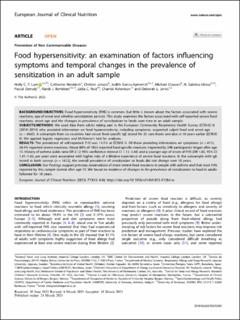| dc.contributor.author | Lam, Holly C. Y. | |
| dc.contributor.author | Neukirch, Catherine | |
| dc.contributor.author | Janson, Christer | |
| dc.contributor.author | Garcia-Aymerich, Judith | |
| dc.contributor.author | Clausen, Michael | |
| dc.contributor.author | Idrose, N. Sabrina | |
| dc.contributor.author | Demoly, Pascal | |
| dc.contributor.author | Bertelsen, Randi Jacobsen | |
| dc.contributor.author | Ruiz, Lidia C. | |
| dc.contributor.author | Raherison, Chantal | |
| dc.contributor.author | Jarvis, Deborah L. | |
| dc.date.accessioned | 2023-11-15T10:45:58Z | |
| dc.date.available | 2023-11-15T10:45:58Z | |
| dc.date.created | 2023-06-28T10:27:30Z | |
| dc.date.issued | 2023 | |
| dc.identifier.issn | 0954-3007 | |
| dc.identifier.uri | https://hdl.handle.net/11250/3102689 | |
| dc.description.abstract | Background/Objectives: Food hypersensitivity (FHS) is common, but little is known about the factors associated with severe reactions, age of onset and whether sensitization persists. This study examines the factors associated with self-reported severe food reactions, onset age and the changes in prevalence of sensitization to foods over time in an adult sample.
Subjects/Methods: We used data from adults taking part in the European Community Respiratory Health Survey (ECRHS) III (2010–2014) who provided information on food hypersensitivity, including symptoms, suspected culprit food and onset age (n = 4865). A subsample from six countries had serum food-specific IgE tested for 25 core foods and also in 10 years earlier (ECRHS II). We applied logistic regression and McNemar’s test for analyses.
Results: The prevalence of self-reported FHS was 13.5% at ECRHS III. Of those providing information on symptoms (n = 611), 26.4% reported severe reactions. About 80% of 1033 reported food-specific reactions (reported by 596 participants) began after age 15. History of asthma (odds ratio OR 2.12 95% confidence interval CI 1.13–3.44) and a younger age of onset of FHS (OR 1.02, 95% CI 1.01–1.03, per year) were associated with higher risks of a lifetime experience of severe food reactions. In the subsample with IgE tested in both surveys (n = 1612), the overall prevalence of sensitization to foods did not change over 10 years.
Conclusion: Our findings support previous observations of more severe food reactions in people with asthma and that most FHS reported by this sample started after age 15. We found no evidence of changes in the prevalence of sensitization to food in adults followed for 10 years. | en_US |
| dc.language.iso | eng | en_US |
| dc.publisher | Springer Nature | en_US |
| dc.rights | Navngivelse 4.0 Internasjonal | * |
| dc.rights.uri | http://creativecommons.org/licenses/by/4.0/deed.no | * |
| dc.title | Food hypersensitivity: an examination of factors influencing symptoms and temporal changes in the prevalence of sensitization in an adult sample | en_US |
| dc.type | Journal article | en_US |
| dc.type | Peer reviewed | en_US |
| dc.description.version | publishedVersion | en_US |
| dc.rights.holder | Copyright 2023 the authors | en_US |
| cristin.ispublished | true | |
| cristin.fulltext | original | |
| cristin.qualitycode | 1 | |
| dc.identifier.doi | 10.1038/s41430-023-01284-w | |
| dc.identifier.cristin | 2158971 | |
| dc.source.journal | European Journal of Clinical Nutrition | en_US |
| dc.source.pagenumber | 833-840 | en_US |
| dc.identifier.citation | European Journal of Clinical Nutrition. 2023, 77, 833-840. | en_US |
| dc.source.volume | 77 | en_US |

